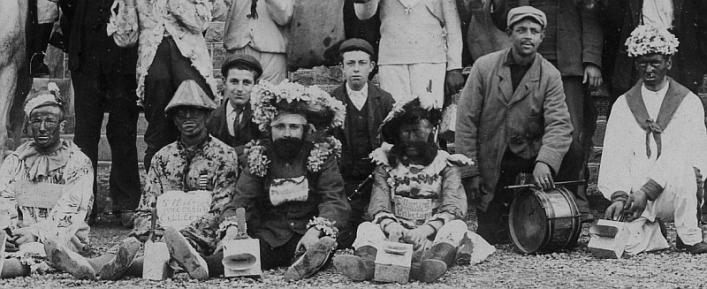Guernsey did not celebrate November 5th until the 19th century, when the 'Guy Fawkes' Night' festival was introduced, probably by British immigrants, and began to replace the traditional burning or burial of the 'budloe' log on New Year's Eve. Late in the century the celebrations were 'officialised'. The photographs are of the procession of 1900; the one above shows the collectors wearing their placards, and the other the budloe paraded on a stretcher.
From the Library's Gazette de L'Ile de Jersey, 10 March 1787. If you're a Jersey person and you think you're cursed, you can call on the local white witch to save you.
A plea by J. Linwood Pitts, Secretary of the Folk Lore section of the Societe Guernesiaise, then the Guernsey Society for Natural History and Local Research) in their Report and Transactions of 1904, p. 313
'The night of 21 December was thought in Guernsey to be a night when spirits walked abroad, when it was dangerous to be outside; but this made it a very auspicious night for magic.' From Guernsey Folk Lore, p. 408.
Guernsey's favourite dance, the rather flirtatious 'Ah! mon beau laurier!.' The illustration is of a modern hurdy-gurdy, or 'chifournie,' used in the old days to accompany the dancing: with thanks to Guernsey Post Office, who also produced a superb video of the chifournie being played in Le Hurel barn in Guernsey. The chifournie has been replaced in Guernsey by the fiddle or accordion in modern times.
Governor Ling thinks poor children are too much of a nuisance; Anne Le Page's remedies don't work and she ends up in the Cage; an interesting proposal from France; Mrs Thomas and Mrs Langworthy have a fight.
From an editorial in the Star of December 12, 1836. The woodcut of a 'frisky' Guernsey pig is from Dr Thomas Bellamy's Pictorial Directory of 1843, in the Library collection. The writer comments on the credulity of those in the country parishes, who continue to venerate such impostors and quacks as Louis D'Orléan, about to face trial for imposition, and in doing so gives us details of the case of Nicolas Roussel which, although having occurred in 1807, 'is not yet forgotten, and just a few particulars respecting it will not, just now, be unacceptable'.
'I have cured persons whom the Doctors had given up; if I am guilty it is of that.' The King versus D'Orléan, the conclusion of a protracted case which opened in the Royal Court, Saturday, December 10th, 1836. Much of the evidence was heard in camera. D'Orléan was practising as a veterinary surgeon. The folk of the country parishes—Judith Lainé, the Bichards, Rihoys, Reniers, Mahys, Galliennes and Ogiers, in this case—are as usual regarded as ill-educated and credulous by Guernsey's sophisticated urbanites. The details of the case are reported in the Comet of February 6, 1837.
In her Report to the Folklore section of the Société Guernesiaise in 1928, Edith Carey drew attention to an interesting custom connected with suicides, based on an inquest held in 1580.
Elie Brevint (1587-1674) was minister of Sark from 1612. His father Cosmé, also a minister, was a Huguenot refugee from Angoulême who had accompanied Helier De Carteret from Jersey in his colonisation of Sark. Transcriptions and microfilm of Elie's 14 Notebooks, which were found in a loft in Sark in the 19th century, are held in the Priaulx Library. Elie appears to be a sensible and rational man with a curious and detached mind, until he turns to these sorts of subject: the Pousseresse, perturbateurs, and salamanders. The illustration is of the Tormento do Tacto, or Torture, from Alexander Périer's O Desengano dos Pecadores of 1724, in the Library.




